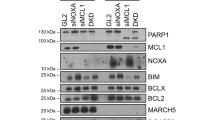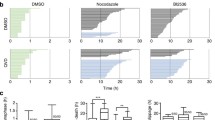Abstract
The BH3-only Bcl-2 subfamily member Bim is a well known apoptosis promoting protein. However, the mechanisms upstream of mitochondrion membrane permeability by which Bim is involved in apoptosis have been poorly investigated, particularly in response to agents capable of interfering with the cytoskeleton architecture and arresting cells in mitosis. Based on the observation that Bim is sequestered on the microtubule-array by interaction with the light chain of dynein, we have investigated upon depolymerisation, whether Bim could be involved in the commitment of apoptosis. With this purpose H460 Non Small Lung Cancer Cells (NSLC) were treated with the microtubule damaging agent combretastatin-A4 (CA-4) (7.5 nM; 8–48 h), and various parameters were investigated. Upon treatment, cells arrested in mitosis and died through a caspase-3-dependent mitotic catastrophe. Transient knock down of Bim drastically reduced apoptosis, indicating that this protein was involved in cell death as induced by microtubules disorganisation. In response to increasing conditions of microtubules depolymerisation, we found that the protein level of Bim was strongly upregulated in a time-dependent manner at transcriptional level. Furthermore, Bim was released from microtubule-associated components. Bim was translocated to mitochondria, even in a condition of protein synthesis inhibition, where it showed a markedly increased interaction with Bcl-2. In turn, the fraction of Bax bound to Bcl-2 decreases in response to treatment, thereby indicating that Bim possibly promotes Bax release from the pro-survival protein Bcl-2. Overall, we demonstrated that Bim is required for the CA-4-induced cell death in the H460 lung cancer cell line via activation of the mitochondrial signalling pathway. Defining the contribution of Bim to the mechanism of apoptosis may offer some different clues in view of developing new strategies for chemotherapy with CA-4, underlining the relevance of the cytoskeleton integrity in the apoptotic response.









Similar content being viewed by others
References
Huang DC, Strasser A (2000) BH3-only proteins—essential initiators of apoptotic cell death. Cell 103:839–842
Cheng EH, Wei MC, Weiler S, Flavell RA, Mak TW, Lindsten T, Korsmeyer SJ (2001) BCL-2, BCL-X-L sequester BH3 domain-only molecules preventing BAX- and BAK-mediated mitochondrial apoptosis. Mol Cell 8:705–711
Lucken-Ardjomande S, Martinou JC (2005) Regulation of Bcl-2 proteins and of the permeability of the outer mitochondrial membrane. C R Biol 328:616–631
Chen L, Willis SN, Wei A, Smith BJ, Fletcher JI, Hinds MG, Colman PM, Day CL, Adams JM, Huang DC (2005) Differential targeting of prosurvival Bcl-2 proteins by their BH3-only ligands allows complementary apoptotic function. Mol Cell 17:393–403
O’Connor L, Strasser A, O’Reilly LA, Hausmann G, Adams JM, Cory S, Huang DC (1998) Bim: a novel member of the Bcl-2 family that promotes apoptosis. EMBO J 17:384–395
O’Reilly LA, Cullen L, Visvader J, Lindeman GJ, Print C, Bath ML, Huang DC, Strasser A (2000) The proapoptotic BH3-only protein Bim is expressed in hematopoietic, epithelial, neuronal, and germ cells. Am J Pathol 157:449–461
Puthalakath H, Huang DC, O’Reilly LA, King SM, Strasser A (1999) The proapoptotic activity of the Bcl-2 family member Bim is regulated by interaction with the dynein motor complex. Mol Cell 3:287–296
Tong T, Ji J, Jin S, Li X, Fan W, Song Y, Wang M, Liu Z, Wu M, Zhan Q (2005) Gadd45a expression induces Bim dissociation from the cytoskeleton and translocation to mitochondria. Mol Cell Biol 25:4488–4500
Strasser A, Puthalakath H, Bouillet P, Huang DC, O’Connor L, O’Reilly LA, Cullen L, Cory S, Adams JM (2000) The role of Bim, a proapoptotic BH3-only member of the Bcl-2 family in cell-death control. Ann N Y Acad Sci 917:541–548
Lei K, Davis RJ (2003) JNK phosphorylation of Bim-related members of the Bcl2 family induces Bax-dependent apoptosis. Proc Natl Acad Sci USA 100:2432–2437
Davis RJ (2000) Signal transduction by the JNK group of MAP kinases. Cell 103:239–252
Puthalakath H, Strasser A (2002) Keeping killers on a tight leash: transcriptional and post-translational control of the pro-apoptotic activity of BH3-only proteins. Cell Death Differ 9:505–512
Dijkers PF, Medema RH, Lammers JW, Koenderman L, Coffer PJ (2000) Expression of the pro-apoptotic Bcl-2 family member Bim is regulated by the forkhead transcription factor FKHR-L1. Curr Biol 10:1201–1204
Sunters A, Fernandez de Mattos S, Stahl M, Brosens J, Zoumpoulidou G, Saunders CA, Coffer PJ, Medema RH, Coombes RC, Lam EW (2003) FoxO3a transcriptional regulation of Bim controls apoptosis in paclitaxel-treated breast cancer cell lines. J Biol Chem 278:49795–49805
Gilley J, Coffer PJ, Ham J (2003) FOXO transcription factors directly activate Bim gene expression and promote apoptosis in sympathetic neurons. J Cell Biol 162:613–622
Estève MA, Carré M, Braguer D (2007) Microtubules in apoptosis induction: are they necessary? Curr Cancer Drug Targets 7:713–729
Jordan MA, Wilson L (2004) Microtubules as a target for anticancer drugs. Nat Rev Cancer 4:253–265
Mollinedo F, Gajate C (2003) Microtubules, microtubule-interfering agents and apoptosis. Apoptosis 8:413–450
Jordan A, Hadfield JA, Lawrence NJ, McGown AT (1998) Tubulin as a target for anticancer drugs: agents which interact with the mitotic spindle. Med Res Rev 8:259–296
Pettit GR, Cragg GM, Singh SB (1987) Antineoplastic agents, 122. Constituents of Combretum caffrum. J Nat Prod 50:386–391
Pettit GR, Singh SB, Boyd MR, Hamel E, Pettit RK, Schmidt JM, Hogan F (1995) Isolation and synthesis of combretastatins A-4, A-5, and A-6. J Med Chem 38:1666–1672
Islam MN, Iskander MN (2004) Microtubulin binding sites as target for developing anticancer agents. Mini Rev Med Chem 4:1077–1104
Wehbe H, Kearney CM, Pinney KG (2005) Combretastatin A-4 resistance in H460 human lung carcinoma demonstrates distinctive alterations in beta-tubulin isotype expression. Anticancer Res 25:3865–3870
Nabha SM, Mohammad RM, Dandashi MH, Coupaye-Gerard B, Aboukameel A, Pettit GR, Al-Katib AM (2002) Combretastatin-A4 prodrug induces mitotic catastrophe in chronic lymphocytic leukaemia cell line independent of caspase activation and poly (ADP-ribose) polymerase cleavage. Clin Cancer Res 8:2735–2741
Vitale I, Antoccia A, Cenciarelli C, Crateri P, Meschini S, Arancia G, Pisano C, Tanzarella C (2007) Combretastatin CA-4 and combretastatin derivative induce mitotic catastrophe dependent on spindle checkpoint and caspase-3 activation in non-small cell lung. Apoptosis 12:155–166
Li R, Moudgil T, Ross HJ, Hu HM (2005) Apoptosis of non-small-cell lung cancer cell lines after paclitaxel treatment involves the BH3-only proapoptotic protein Bim. Cell Death Differ 12:292–303
Czernick M, Rieger A, Goping IS (2009) Bim is reversibly phosphorylated but plays a limited role in paclitaxel cytotoxicity of breast cancer cell lines. Biochem Biophys Res Commun 379:145–150
Cenciarelli C, Tanzarella C, Vitale I, Pisano C, Crateri P, Meschini S, Arancia G, Antoccia A (2008) The tubulin-depolymerising agent combretastatin-4 induces ectopic aster assembly and mitotic catastrophe in lung cancer cells H460. Apoptosis 13:659–669
Zhu YN, Swanson BJ, Wang M, Hildeman DA, Schaefer BC, Liu XQ, Suzuki H, Mihara K, Kappler J, Marrack P (2004) Constitutive association of the proapoptotic protein Bim with Bcl-2-related proteins on mitochondria in T cells. Proc Natl Acad Sci USA 101:7681–7686
Butt AJ, Roberts CG, Seawright AA, Oelrichs PB, Macleod JK, Liaw TY, Kavallaris M, Somers-Edgar TJ, Lehrbach GM, Watts CK, Sutherland RL (2006) A novel plant toxin, persin, with in vivo activity in the mammary gland, induces Bim-dependent apoptosis in human breast cancer cells. Mol Cancer Ther 5:2300–2309
Maginn EN, Browne PV, Hayden P, Vandenberghe E, MacDonagh B, Evans P, Goodyer M, Tewari P, Campiani G, Butini S, Williams DC, Zisterer DM, Lawler MP, McElligott AM (2011) PBOX-15, a novel microtubule targeting agent, induces apoptosis, upregulates death receptors, and potentiates TRAIL-mediated apoptosis in multiple myeloma cells. Br J Cancer 104:281–289
Erlacher M, Michalak EM, Kelly PN, Labi V, Niederegger H, Coultas L, Adams JM, Strasser A, Villunger A (2005) BH3-only proteins Puma and Bim are rate-limiting for gamma-radiation- and glucocorticoid-induced apoptosis of lymphoid cells in vivo. Blood 106:4131–4138
Tan TT, Degenhardt K, Nelson DA, Beaudoin B, Nieves-Neira W, Bouillet P, Villunger A, Adams JM, White E (2005) Key roles of BIM-driven apoptosis in epithelial tumors and rational chemotherapy. Cancer Cell 7:227–238
Tozer GM, Kanthou C, Parkins CS, Hill SA (2002) The biology of the combretastatins as tumour vascular targeting agents. Int J Exp Pathol 83:21–38
Sunters A, Madureira PA, Pomeranz KM, Aubert M, Brosens JJ, Cook SJ, Burgering MT, Coombes RC, Lam EW (2006) Paclitaxel-induced nuclear translocation of Foxo3a in breast cancer cells is mediated by c-Jun NH2-Terminal kinase and Akt. Cancer Res 66:212–220
Kuwana T, Mackey MR, Perkins G, Ellisman MH, Latterich M, Schneiter R, Green DR, Newmeyer DD (2002) Bid, Bax, and lipids cooperate to form supramolecular openings in the outer mitochondrial membrane. Cell 111:331–342
Acknowledgments
Gina Marcela Mendez is a PhD fellow at the Department of Biology, Università Roma Tre. We are grateful to Mr. Ed Kerman and Mrs. L. Mattace for English editing.
Author information
Authors and Affiliations
Corresponding author
Additional information
G. Mendez and C. Policarpi contributed equally to the article.
Rights and permissions
About this article
Cite this article
Mendez, G., Policarpi, C., Cenciarelli, C. et al. Role of Bim in apoptosis induced in H460 lung tumor cells by the spindle poison Combretastatin-A4. Apoptosis 16, 940–949 (2011). https://doi.org/10.1007/s10495-011-0619-8
Published:
Issue Date:
DOI: https://doi.org/10.1007/s10495-011-0619-8




